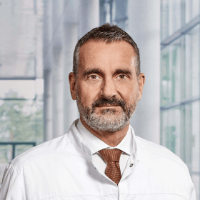Pulmonary Valve Stenosis — Pulmonary Valve Replacement: treatment in the Best Hospitals of Germany
Treatment prices are regulated by national law of the corresponding countries, but can also include additional hospital coefficients. In order to receive the individual cost calculation, please send us the request and medical records.

Department of Cardiothoracic Surgery
According to the Focus magazine, the Department of Cardiothoracic Surgery ranks among the top German medical facilities specializing in the surgical treatment of diseases of the cardiovascular system and lung cancer! The department offers the full range of surgical services for the treatment of diseases of the cardiovascular system, respiratory tract, including heart and lung transplantation, artificial heart implantation. The therapeutic options include aortic surgery, coronary artery bypass grafting, transplantation surgery, surgical treatment of heart rhythm disorders (arrhythmias), minimally invasive surgery, surgical treatment of the heart valves, including reconstructive interventions. All operations are performed using state-of-the-art technology and in accordance with the current recommendations of professional societies.






Department of Cardiac Surgery
The Department of Cardiac Surgery provides a full range of surgical treatment in its area of specialization. Special emphasis is placed on heart valve repair and replacement surgery, coronary artery bypass grafting, thoracic aortic surgery, adult congenital and acquired heart disease surgery, pacemaker and defibrillator implantation, and artificial heart implantation for severe heart failure. Many heart operations are performed using minimally invasive techniques, which has a positive effect on the healing of the surgical wound. Minimally invasive cardiac procedures also reduce surgical risks and contribute to a rapid recovery of the patient in the postoperative period. Surgical treatment of cardiac pathologies is performed in advanced operating rooms equipped with the latest technology. The cardiac surgeons of the department successfully perform routine and complex surgical procedures, saving the lives of thousands of patients. The specialists work in accordance with current clinical protocols and follow the recommendations of the German Society for Thoracic and Cardiovascular Surgery (DGTHG).


Department of Cardiothoracic Surgery and Vascular Surgery
The Department of Cardiothoracic Surgery and Vascular Surgery provides effective surgical treatment for diseases of the heart, respiratory system, and blood vessels. The team of cardiac surgeons operates on patients with heart valve pathologies, coronary heart disease, heart failure, and heart rhythm disturbances. In the field of thoracic surgery, the key focus is on the surgical removal of lung tumors and lung metastases. The specialists in this area also perform surgery to repair chest wall deformities. In the field of vascular surgery, interventions for abdominal and thoracic aortic aneurysms are most often performed here. The department's vascular surgeons are also exceptionally competent in the treatment of peripheral occlusive arterial disease. A great advantage for the department's patients is that almost all surgical interventions are performed using minimally invasive techniques, so there is no need for a long postoperative recovery. The department's operating rooms are equipped with state-of-the-art technology. This allows for effective and safe treatment. The priority is always personalized medical care for patients.






Pulmonary valve stenosis is a common congenital heart disease in children. Both minimally invasive and surgical methods can be used for its treatment. The indication for treatment is a pressure gradient between the pulmonary trunk and the right ventricle of 50 mmHg or more.
Content
- Who may be a candidate for prosthetic pulmonary valve replacement?
- How is prosthetic pulmonary valve replacement performed?
- Revision prosthetic pulmonary valve replacement
The first replacement surgery is usually performed using open surgical techniques through an incision in the chest. Doctors implant predominantly biological prostheses to avoid the formation of blood clots. Repeated prosthetics can be performed using endovascular techniques without opening the chest.
You can seek medical attention at the University Hospital Essen, the University Hospital Ulm, or the University Hospital Oldenburg.
You are welcome to use the services of the medical tourism agency Booking Health to travel to Germany and undergo your treatment at one of the world's best hospitals. We will contact the hospital administration and make an appointment for your preferred dates. We will also book a hotel room and airline tickets, meet you at the German airport, and take you to the hospital by car. You will receive support throughout your stay in another country.
Who may be a candidate for prosthetic pulmonary valve replacement?
Prosthetic pulmonary valve replacement in Germany is not considered a first-choice treatment for stenosis in Germany. Whenever possible, cardiosurgery doctors perform a minimally invasive procedure for pulmonary valve repair called a balloon valvuloplasty. It does not require opening the chest. The advantages are high success rates and short recovery times.
Nevertheless, in the case of leaflet dysplasia, pulmonary valve stenosis treatment in Germany is performed using replacement surgery. This is a complicated open procedure that should only be performed at reputable clinics.
How is prosthetic pulmonary valve replacement performed?
Surgery is done through an incision in the chest with a connection to a heart-lung machine. Doctors implant an artificial heart valve instead of the patient's own inside the pulmonary trunk.
Pulmonary valve prostheses are almost always biological, not mechanical. This is due to the fact that the placement of mechanical prostheses may result in the formation of blood clots. The risk of their occurrence is higher than in the region of the heart valves in the left half of the heart. At the same time, the risk remains elevated, despite the constant use of anticoagulants.
Revision prosthetic pulmonary valve replacement
Biological artificial pulmonary valves last up to 10 years in children and up to 30 years in adult patients. In some patients, they may wear out sooner. If prosthetic dysfunction occurs, the previously implanted prosthesis must be replaced.
To do this, repeated open surgery is usually performed. In addition, pulmonary valve prosthetics in Germany can be performed using minimally invasive techniques through a small incision in the leg. A new artificial heart valve is implanted inside the old heart valve prosthesis. This innovative prosthetic technique reduces the number of open-heart surgeries patients undergo during their lifetime.
You are welcome to use the Booking Health service to undergo your treatment at one of the cardiosurgery departments in Germany. On our website, you can find out the surgical treatment cost and choose a medical care program at one of the hospitals with cardiosurgery departments at the best price. Our employees will help you select the most suitable clinic and organize your trip.
Authors:
The article was edited by medical experts, board-certified doctors Dr. Nadezhda Ivanisova and Dr. Vadim Zhiliuk. For the treatment of the conditions referred to in the article, you must consult a doctor; the information in the article is not intended for self-medication!
Sources:
European Society of Cardiology

